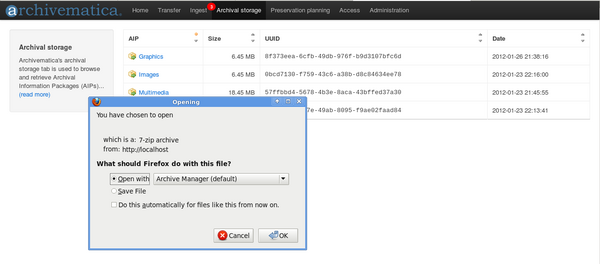Difference between revisions of "UM error handling"
Jump to navigation
Jump to search
| Line 2: | Line 2: | ||
== General description == | == General description == | ||
| − | + | Archivematica anticipates that a number of different types of errors can occur during processing. Some of them will result in processing being halted and the transfer or SIP being moved to the failed directory in the file browser. For others, processing can continue: for example, a normalization failure is reported and the user is given the opportunity to continue processing the SIP. | |
| + | == Dashboard error reporting == | ||
| + | #When a micro-service fails or encounters an error, the micro-service background turns from green to pink and a "failed" icon appears next to the transfer or SIP name ('''figure 1'''). [[Image:virusScanError.png|600px|right|thumb|'''Figure 1''' AIPs stored in the default AIPsStore directory in quad-UUIDs.]] | ||
| − | #Once ingest is complete, selecting "Store AIP" in the Actions drop-down menu compresses and zips the AIP and moves it into Archival storage. | + | |
| + | #Once ingest is complete, selecting "Store AIP" in the Actions drop-down menu compresses and zips the AIP and moves it into Archival storage. | ||
#In the demo version of Archivematica the AIP storage directory is ''/sharedDirectoryStructure/www/AIPsStore/'' ('''figure 1'''). In other environments it can be a remote network mounted directory. | #In the demo version of Archivematica the AIP storage directory is ''/sharedDirectoryStructure/www/AIPsStore/'' ('''figure 1'''). In other environments it can be a remote network mounted directory. | ||
#The AIP directories are broken down into UUID quad directories for efficient storage and retrieval. | #The AIP directories are broken down into UUID quad directories for efficient storage and retrieval. | ||
Revision as of 17:21, 27 January 2012
Main Page > Documentation > User manual > User manual 0.8 > Error handling
General description
Archivematica anticipates that a number of different types of errors can occur during processing. Some of them will result in processing being halted and the transfer or SIP being moved to the failed directory in the file browser. For others, processing can continue: for example, a normalization failure is reported and the user is given the opportunity to continue processing the SIP.
Dashboard error reporting
- When a micro-service fails or encounters an error, the micro-service background turns from green to pink and a "failed" icon appears next to the transfer or SIP name (figure 1). File:VirusScanError.pngFigure 1 AIPs stored in the default AIPsStore directory in quad-UUIDs.
- Once ingest is complete, selecting "Store AIP" in the Actions drop-down menu compresses and zips the AIP and moves it into Archival storage.
- In the demo version of Archivematica the AIP storage directory is /sharedDirectoryStructure/www/AIPsStore/ (figure 1). In other environments it can be a remote network mounted directory.
- The AIP directories are broken down into UUID quad directories for efficient storage and retrieval.
- The Archival storage tab in the Archivematica dashboard consists of a table with information about the stored AIPs (figure 2). Use the up and down arrows in the column headers to sort by AIP name, size, UUID or date. Note that at the bottom of the Size column is the total size of the stored AIPs.
- To open a copy of the AIP, click on the AIP name. You can then open or download the zipped AIP (figure 3).
- More information on Archivematica's AIP structure and the METS/PREMIS file is available on the Archivematica wiki: see AIP structure and METS.

